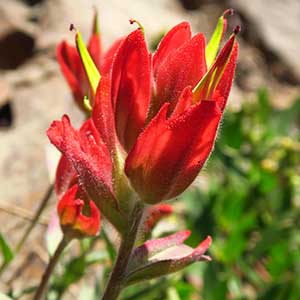Castilleja pallescens
Castilleja elmeri
dwarf pale paintbrush, pale Indian paintbrush, pale paintbrush
Elmer's Indian paintbrush, Elmer's paintbrush, Wenatchee Indian paintbrush, Wenatchee paintbrush
few to many, erect to ascending, decumbent at base, unbranched, sometimes branched, hairs moderately to very dense, retrorsely curved to appressed, short, ± stiff, eglandular.
solitary or few to many, erect to ascending, sometimes slightly curved at base, unbranched, rarely branched, hairs moderately dense, spreading, medium length, soft, mixed with shorter eglandular and stipitate-glandular ones, at least on distal 1/2 of stem.
purple-tinged or deep purple, sometimes green, linear to narrowly lanceolate, 1–4(–5) cm, not fleshy, margins plane, sometimes ± wavy, ± involute, (0–)3–5(–7)-lobed, apex acute;
lobes spreading or ascending-spreading, linear, apex acute.
green, rarely purple-tinged, linear-lanceolate, sometimes linear or lanceolate, 1.3–6.5 cm, not fleshy, margins plane, flat or involute, entire, apex acute.
(1.5–)4–8(–12) × 1.5–5.5 cm;
bracts pale green to yellow-green or reddish purple throughout, or proximally pale green to yellow-green, distally white to cream or pale yellowish, sometimes pink to reddish purple, lanceolate to linear-lanceolate, elliptic, or ovate, 3–5(–9)-lobed;
lobes spreading to ascending, linear, long, arising along distal 2/3, apex acute to obtuse.
2.5–9 × 1.5–3 cm;
bracts red, crimson, scarlet, pink, magenta, red-orange, burnt orange, orange, pale yellow, or whitish throughout, or proximally greenish, distally as stated above, oblong, narrowly obovate, elliptic-oblong, or narrowly ovate, 0(–5)-lobed, rarely with 1 or 2 pairs of short, usually distal lobes;
lobes ascending, lanceolate, very short, arising from distal edge, apex rounded to obtuse.
0 mm.
straight, 13–23(–27) mm;
tube 10–20 mm; subequal to calyx or beak slightly exserted;
beak adaxially whitish or buff, rarely pink to pink-purple, 3.5–8 mm;
abaxial lip proximally green, white, purple, or purplish brown, distally white, yellow, green, pink, or reddish, prominent, pouched, pouches pleated, longer than deep, gradually expanded, 2.5–8 mm, 70–100% as long as beak, puberulent;
teeth erect to spreading, pink, cream, or white, sometimes with a yellow spot proximally, 1.5–3.5 mm.
straight, 20–33 mm;
tubes 13–18 mm;
beak, and sometimes abaxial lip, partially to fully exserted;
beak adaxially green to yellowish, 8–15 mm;
abaxial lip incurved, green, thickened, 2–3 mm, 20–33% as long as beak;
teeth ascending or incurved, green, 0.5–1 mm.
colored as bracts, sometimes distally purple with age, 11–25(–27) mm;
abaxial and adaxial clefts 7–13.6 mm, 40–50% of calyx length, deeper than laterals, lateral 0.5–4.3(–6) mm, (0–)5–25% of calyx length;
lobes lanceolate to triangular, apex usually triangular or acute, rarely ± obtuse.
proximally green to pale green, distally colored as bracts, 15–25 mm;
abaxial and adaxial clefts 5–14 mm, 33–50% of calyx length, deeper than laterals, lateral 1–4 mm, 6–20% of calyx length;
lobes lanceolate to narrowly triangular, apex rounded to obtuse.
= 24, 48.
= 48.
Castilleja pallescens
Castilleja elmeri
Varieties 2 (2 in the flora).
Castilleja pallescens occurs from valleys to alpine ridges and summits throughout its range, usually in sagebrush communities, but at higher elevations it is also found on dry sites associated with other plant species. The alpine plants are greatly reduced in stature.
(Discussion copyrighted by Flora of North America; reprinted with permission.)
The bracts and inflorescences of Castilleja elmeri can be red, crimson, scarlet, pink, magenta, red-orange, burnt orange, orange, pale yellow, or whitish. While the coloration is highly variable between local populations, it is usually uniform and consistent within them. It is found primarily in the Wenatchee Mountains of Washington, where it is often on serpentine, but it ranges northward in the Cascades into extreme southern British Columbia, apparently on non-serpentine substrates. Hybrids with C. miniata var. miniata, C. parviflora var. albida, and C. thompsonii have been found in the eastern Cascades of Washington, and a similar hybrid swarm with C. thompsonii is reported from southern British Columbia.
(Discussion copyrighted by Flora of North America; reprinted with permission.)
1. Bracts not rigid, veins inconspicuous, usually same color as surfaces; herbs (0.5–)1–3 dm; ne Idaho, sw Montana, nw Wyoming. | var. pallescens |
1. Bracts rigid, veins prominent, pale and contrasting with color of surfaces; herbs 0.4–1.2(–1.7) dm; s, se Idaho, ne Nevada, Oregon. | var. inverta |


